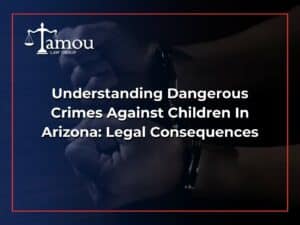Today, we’re honing in on a crucial element of Arizona’s criminal law landscape: the classifications of felonies. By breaking down this complex topic, we hope to shed light on the consequences of different types of felonious acts within our state.
An Overview of Felony Classes
As mentioned in our previous blog post, felonies in Arizona are broken down into six classes. The classification of a felony is primarily based on the seriousness of the crime, with Class 1 being the most serious and Class 6 the least. Each class carries a different range of possible sentences, which can be further influenced by factors like prior convictions and the specific circumstances of the crime.
Class 1 Felonies: The Most Severe Category
Class 1 felonies are the most serious crimes under Arizona law. This class includes crimes such as first-degree murder (Arizona Revised Statutes § 13-1105) and second-degree murder (Arizona Revised Statutes § 13-1104). If convicted of a Class 1 felony, an individual faces the harshest penalties, including life imprisonment or even the death penalty for first-degree murder.
Classes 2 to 4 Felonies: Serious Offenses
Classes 2, 3, and 4 felonies include serious offenses such as aggravated assault, burglary, and certain drug offenses. For example, a crime such as sexual assault is classified as a Class 2 felony under Arizona Revised Statutes § 13-1406. These felonies carry significant prison terms and fines.
Classes 5 and 6 Felonies: The Least Severe Category
Class 5 and 6 felonies, while still serious, are considered the least severe felony categories. Examples include theft of property valued between $1,000 and $2,000, a Class 5 felony (Arizona Revised Statutes § 13-1802), or possession of certain controlled substances, a Class 6 felony (Arizona Revised Statutes § 13-3407). Despite being on the lower end of the felony scale, these crimes can still result in significant legal consequences, including imprisonment and hefty fines.
Mitigating and Aggravating Factors
In sentencing for felonies, Arizona law considers both mitigating and aggravating factors. Mitigating factors, like lack of a prior criminal record or evidence of remorse, can reduce the severity of a sentence. On the other hand, aggravating factors, such as a crime’s brutality or a prior criminal record, can lead to a harsher sentence.
In Conclusion
Arizona’s felony classification system plays a crucial role in understanding the potential consequences of criminal actions. The system allows for nuanced sentencing that reflects the severity and specific circumstances of each crime. However, these classifications and associated penalties underline the serious nature of felony charges, and the importance of skilled legal representation if you or someone you know faces such charges.
Remember, while this blog is designed to educate and inform, it should not replace the counsel of a professional attorney when faced with legal issues.

Tamou Law Group
Scottsdale Office
9375 E Shea Blvd #100
Scottsdale, AZ 85260
Phone: 623-321-4699


![The Top 3 Probation Violation Lawyers in Phoenix, AZ [2025]](https://tamoulawgroup.com/wp-content/uploads/2025/11/phoenix-probation-violation-lawyer-300x300.png)
![How to Beat a DUI Charge in Phoenix, AZ [2025]](https://tamoulawgroup.com/wp-content/uploads/2025/08/best-phoenix-dui-lawyers-300x300.png)